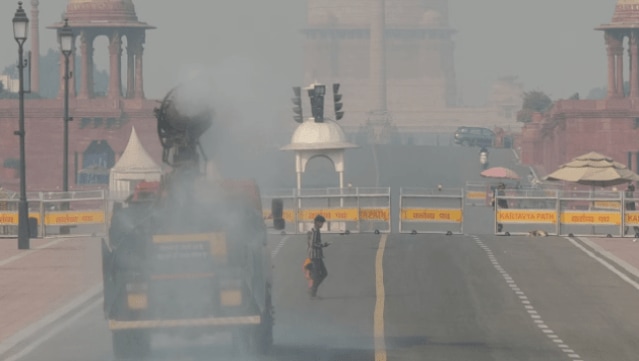Work-from-home could start sooner, staggered office timings could kick in at lower levels of pollution: What CAQM has suggested in fight against toxic air in Delhi-NCR
The air pollution watchdog has proposed a series of measures tightening the GRAP restrictions on living, travelling, and working. They are yet to be notified – but even when that happens, implementation will remain key.
 CAQM has proposed advancing key pollution-control measures under GRAP so they activate at earlier AQI levels in Delhi-NCR. (PTI Photo)
CAQM has proposed advancing key pollution-control measures under GRAP so they activate at earlier AQI levels in Delhi-NCR. (PTI Photo)The Commission for Air Quality Management (CAQM), the air pollution watchdog for Delhi-NCR, has proposed a major rejig of the Graded Response Action Plan (GRAP), moving up several measures to earlier stages.
This essentially means that a range of actions relating, for example, to the ways in which citizens travel or work, will kick in at lower levels of air pollution than they currently do. The changes are only suggestions as of now – CAQM has not notified them yet.
How GRAP works
GRAP is a mechanism to decide the actions that governments in Delhi-NCR must take as the levels of air pollution rise through various stages. The idea of GRAP is to put certain steps or restrictions in place as soon as air pollution reaches a specific level, instead of waiting for the air to become worse.
The GRAP framework was approved by the Supreme Court in 2016, and its implementation has since been overseen by the CAQM. The watchdog’s suggestion to the Supreme Court on Wednesday (November 19) was part of a new set of interventions it was required to present before the court.
There are four stages in GRAP, each linked to the Air Quality Index (AQI) at the time. The first stage, or Stage I of GRAP, kicks in when the air turns “poor” – with an AQI of 201-300, which causes breathing discomfort to most people on prolonged exposure.
Stage II kicks in when the air quality worsens to “very poor” (AQI of 301-400, which can cause respiratory illness on prolonged exposure), and Stage III is reached during “severe” pollution (AQI of 401-500, during which healthy people are affected and those with existing diseases are seriously impacted).
Stage IV of GRAP is reached when conditions enter the “severe+” range, with an AQI of more than 500.
India’s national AQI system has been developed by the Central Pollution Control Board (CPCB), which classifies air quality based on the ways in which health can be impacted at various pollution levels, ranging from minor discomfort to serious respiratory and cardiovascular risks.
A set of measures is prescribed for governments to implement at each stage of GRAP, such as controlling road dust, reducing traffic congestion, restricting construction activities, or limiting industrial emissions.
When a higher stage of GRAP is triggered, the actions from the earlier stages remain in place. Therefore, GRAP functions as a step-by-step escalation of measures as pollution worsens, aiming to slow down the increase in pollution levels, and to prevent pollution from reaching the most harmful levels.
At present, GRAP III is effective in the capital, as the levels of air pollution have moved between ‘severe’ and ‘very poor’ levels. A set of restrictions that correspond to this stage of GRAP are in place.
What is suggested
The CAQM has recommended that measures such as expanded public transport (thereby reducing the need for people to take their own vehicles), higher metro frequency with differential fares, and staggered timings for government offices and municipal bodies (so that fewer people are on the road at the same time and traffic congestion and idling times are reduced) should to be moved to earlier stages of GRAP.
This what has been suggested should change.
* Move from GRAP Stage II to Stage I: Uninterrupted power supply, enhanced traffic management, pollution alerts, and expanded public transport with off-peak incentives.
* Move from Stage III to Stage II: Staggered timings for public offices and municipal bodies in key NCR districts; NCR state governments and the Centre will be free to take similar decisions for their offices across Delhi-NCR.
* Move from Stage IV to Stage III: Operating offices at 50% strength with work-from-home. This is to be decided by NCR states for local offices and by the Centre for central offices.
Recommendations beyond GRAP
Beyond the GRAP revisions, the CAQM has also outlined short-term steps that, if implemented, would directly change aspects of daily living in the NCR cities.
These include (i) clearing traffic bottlenecks, (ii) deploying more mechanised sweepers to cut dust on busy roads, (iii) strengthening surprise checks on industries and construction sites, and (iv) pushing Punjab and Haryana to ensure brick kilns shift to cleaner paddy-straw pellets. State governments in NCR would also be required to expedite the notification of their policies on vehicle aggregators (cab and delivery-app platforms).
How will you be impacted?
For residents, the long-term proposals would mean a quicker shift to electric vehicles with better incentives, higher costs for big diesel SUVs, smoother traffic through IT-enabled systems, and fewer high-emission vehicles on the road.
States would also need to enforce stricter norms for polluting industries, improve stubble- and waste-management, reduce road dust, and stop new coal-based power plants within 300 km of Delhi.
When are these changes likely to be implemented?
A senior CAQM official said, “We proposed short-term and long-term measures (to tackle air pollution) after the Supreme Court’s order on November 17. There are some [earlier] court orders that we need to consider before taking any implementable decisions. These particular ones in the proposal [presented to the court on Wednesday] should be all right to implement, but it depends on the SC’s directions.”
On Wednesday, meanwhile, the CAQM wrote to NCR state governments to shift physical activities for school children from November and December to cleaner months.







